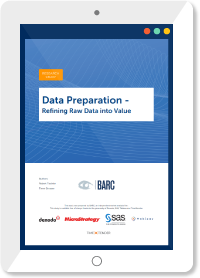Free survey
Data Preparation – Refining Raw Data into Value
This study clearly demonstrates the benefits, timeliness and relevance of data preparation for analytics.
Download for free now!

This study addresses the following key questions:
- The role of data pre-processing by IT and specialist departments (data preparation) in the analytical landscapes of companies.
- The current state and future plans of organizations in the field of data preparation.
- The measures taken by companies to achieve an appropriate and contemporary level of analytical flexibility without compromising data governance and data quality.
Join over 250,000 annual readers!
“BARC surveys give me a practical overview of what’s out there in the market and what you don’t normally hear about data, BI and analytics in your day-to-day life”.
Pietro Grammatico, Director Service Management BI, Vorwerk
Sponsors


Further information
The increasing digitalization of business processes is making it necessary for companies to enable as many users as possible to gain insights from data (democratization of analytics). Many companies today view data preparation as the key to increasing their ability to efficiently use data in a distributed manner to optimize business processes, or to enabling new, innovative business models in the first place.
The goal of data preparation is to support business analysts and data scientists by preparing different kinds of data for their analytical purposes. The preparation of data can take place either in business departments or be performed centrally by IT. Data preparation is a sub-domain of data integration that can be executed with dedicated tools or traditional tools for data integration like ETL tools, data virtualization or data warehouse automation.
This study clearly demonstrates the benefits, timeliness and relevance of data preparation for analytics. It shows how and by whom data preparation is being driven and how the balancing act between governance and flexibility can be achieved by specifying the requirements for data preparation governance. We also show how data preparation is used today, which challenges need to be overcome, and in which organizational framework this takes place.
The key findings from “Data Preparation – Refining Raw Data into Value” are condensed into seven “hot spots”, each designed to help organizations optimize their approach to – and achieve the maximum benefits from – data preparation.
FAQ
Absolutely! We want to provide you with free knowledge that can benefit you in your work. Keep us in mind when you need assistance with your next project!
We ask you to provide some information in exchange for our free content so we can send you information from time to time that may be of interest to you.
Since we operate in the B2B space, we only accept registrations from business addresses. If for some reason you would like to register with your private email address, please contact us directly at info@barc.de.
Here is some guidance:
- If your company does not offer software consulting or solutions, and the use of one or more software solutions (e.g., BI or ECM solutions) is either part of your everyday work or in the pipeline, then please select the option "work for a software user company" regardless of your industry sector or company size.
- Do you work for a company that offers software solutions (e.g., BI or ECM solutions)? Then please select "work for a software provider".
- If your company offers IT/software consulting or services, then "work for an IT service provider/consulting firm" is the right choice.
- Do you work or study in an educational institution such as a university or a research institute? Then choose "work/study in an educational institution".
- Do you work as an IT journalist and write technical articles, features, blogs etc. for media companies? Then please click on "work as a journalist".
- Does your company invest in companies in the B2B software sector? Then please select "work for an investment company."
- If you do not feel you belong to any of the above categories, please select "None of the above/Other".
If you are unable to submit the form, please copy the URL of this page and open it in another browser. Google Chrome usually works fine. If that doesn’t work, please try Firefox, Microsoft Edge or Safari.
If you have not received an email with a link to the content after several minutes, please do the following:
- Check your spam folder. Did the email land there? If not...
- Have you unsubscribed from all BARC mailings in the past? Check this by entering your email address in the form. If the text " Looks like you've opted out of email communication. Click here to get an email and opt back in." appears below your email address, click on it. We will then send you an automated email. Click on the link in the email to enter your "Subscription Center". To ensure you receive an email with the link to free content, please select "BARC products and services". Now fill out the form again. If you still do not receive an email, please continue with step 3.
- Are BARC’s email sending domains blocked in your company? This could be the case if your colleagues do not receive BARC mailings either. Please ask your IT/email team to add BARC's email sending domain to their allowlist. This will enable you to receive emails from BARC. That wasn't the problem either? Then off to step 4.
- It seems that we made a mistake. We apologize for that. Please contact info@barc.com and describe your problem in detail, if possible with screenshots. We will find a solution as soon as possible. Promise!
Download for free now!